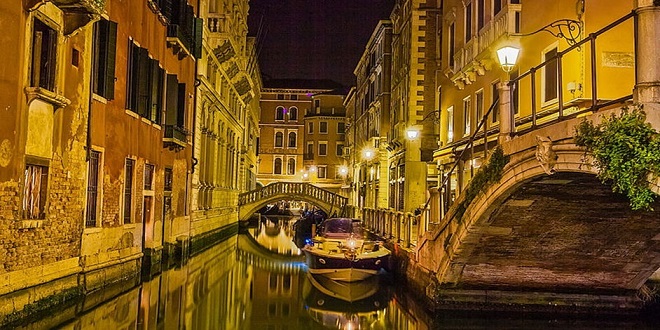Less-Explored Venice

Any trip to this waterborne city inevitably starts at Piazza San Marco, with its entourage of glittering monuments. Here are photo opportunities galore, including feeding pigeons and rooftop views from the Campanile (bell tower). A trip in a gondola rowed by a handsome gondolier, as you glide on the magnificent Grand Canal beneath the majestic Rialto arch, is about as delightfully stereotypical as it can get. But there is much more of Venice to be experienced, hidden away in the city’s backwaters.
perienced, hidden away in the city’s backwaters. All it takes is a wrong turn, a detour from the tourist trails and the maddening crowds are left behind as you wander into the real Venice, where the locals live, work, and socialize. In this maze of alleys, wonderful rewards come in the form of authentic neighborhood cafés and canalside wine bars, or osteria, buzzing with the sounds of the local Venetian dialect.
These are inviting places for a relaxed morning cappuccino, an unhurried alfresco lunch, or a spritz apéritif, later in the day. Wander farther to discover tiny squares where kids play soccer and neighbors settle down to chat beside Renaissance churches housing exquisite works of art.
The immense 210-sq-mile (550-sq-km) expanse of the Venice lagoon has much to offer visitors, too. Its waters are dotted with islands that have been inhabited since Roman times and through the Middle Ages. There are still hosts of monasteries (albeit abandoned), the famous lazaretti, or hospitals, constructed for plague victims and lepers, and small but thriving fishing communities. Barely navigable channels snake through shallows and salt marshes. The northern stretch harbors fish farms, market gardens, and open spaces where herons, cormorants, and flamingoes come to breed.
The public waterbus, or vaporetto, runs out to Murano, with its world-famous glass; Burano, known for its lace; and Torcello, where the first lagoon dwellers settled. The lagoon’s southern end features islands with multiple uses, from being ancient ammunition dumps to havens for refugees.
THE BUILD-UP
The dazzling array of must-see sights includes grandiose Piazza San Marco, and the intricately decorated Doge’s Palace. Then there’s the bejeweled Basilica of St. Mark and its treasures, and the myriad museums and churches that showcase the glorious Renaissance art created here. Hours can be spent on the city’s main water artery, the Grand Canal, lined with palaces and crossed by four major bridges.
THE LETDOWN
You’ll be hard put to have the famous square to yourself, day or night. Waiting and jostling in line become familiar pastimes at top sights and prices are sky high at every corner.
PRACTICAL INFORMATION
Getting There and Around
Marco Polo airport is 6 miles (10 km) northeast of Venice. Buses take 20 minutes to reach the city and launches about 45 minutes. The city is best explored on foot, although the public ferry or vaporetto makes for a relaxing cruise.
Where to Eat
Food in Venice centers on seafood. Exclusive Da Fiore (www.dafiore.net) in the San Polo district specializes in dishes made from seasonal ingredients. Or opt for La Caravella, where traditional fare is reinterpreted
When to Go
Winter can be sunny and crisp, with fewer crowds. However, take heed that in the months of October, November, and December, you are more likely to encounter flooding, known as Acqua Alta. Spring (Mar–May) is lovely, as a little warmth streams into the sun’s rays.
Last word
Farther south, joining the mainland, the lively fishing port of Chioggia is worth a visit for its sandy beach and fish restaurants. A little off the beaten track, these backwaters of the “floating” city hide a uniquely Venetian allure.





